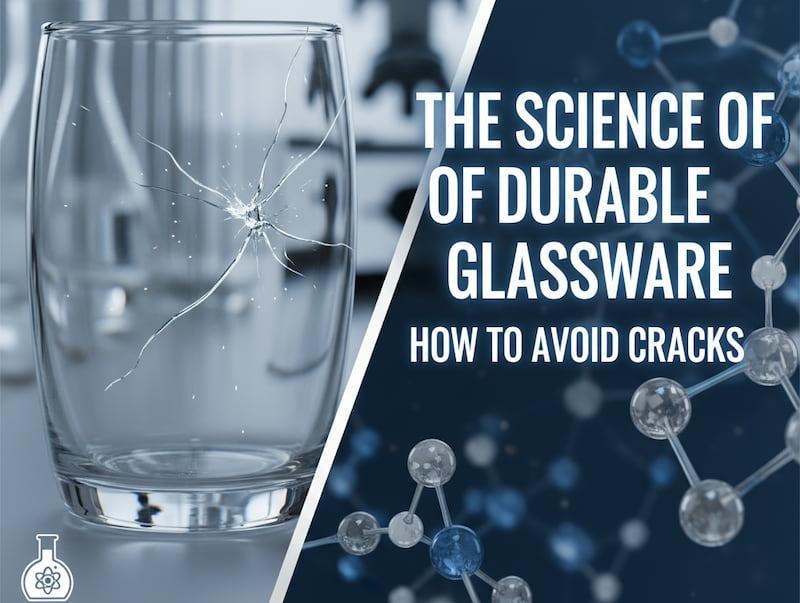It’s a sound that every glassware owner dreads: that sharp, sudden ping of cracking glass. This fear often comes from a phenomenon called thermal shock, the stress placed on glass when it’s heated or cooled too quickly. The good news is that this is almost entirely preventable, and the secret isn’t in how you handle the piece, but in what it’s made of. This guide will explain the simple science of heat-resistant glassware, show you why borosilicate glass is the industry standard for durability, and give you simple tips to ensure your next piece is built to last.
The Real Culprit: Understanding Thermal Shock
Why does glass crack from heat in the first place? Think of a cold glass dish from the refrigerator. If you were to immediately pour boiling water into it, the inner surface would expand rapidly from the heat while the outer surface remained cold and contracted. This difference in expansion creates immense stress on the material, causing it to crack. This is thermal shock. While this is a risk with standard, everyday glass, it’s a problem that has been solved by material science for decades.
The Solution: Borosilicate Glass, The Industry Standard
The hero of our story is a special type of glass called borosilicate. You might already know it by a famous brand name: Pyrex. By adding an element called boric oxide to the glass mixture during its creation, scientists developed a material with a very low coefficient of thermal expansion.
In simple terms, this means borosilicate glass does not expand or contract much when exposed to heat. This key property gives it three incredible advantages:
- Extreme Heat Resistance: It can handle rapid temperature changes without cracking, which is why it’s the required material for laboratory beakers and high-end kitchenware.
- Superior Durability: The manufacturing process and chemical makeup of borosilicate glass also make it physically stronger and more resistant to accidental drops and bumps than standard glass.
- Purity of Flavor: Borosilicate is non-porous and inert, meaning it won’t absorb old flavors or odors. This ensures a clean, pure taste every single time.
How to Spot Quality, Heat-Resistant Glassware
Now that you know what to look for, here are three simple tips to use when you’re shopping to ensure you’re getting a durable, heat-resistant piece.
- Check the Product Description: Reputable sellers will be proud to state that their products are made from borosilicate glass. Look for this term in the product details. Its presence is a clear sign of quality.
- Feel the Thickness: While not always a perfect indicator, thicker glass (often measured in millimeters, like 5mm or 7mm) generally offers better durability and heat retention than thin, flimsy-feeling glass.
- Inspect the Joints: The weak point of any glass piece is often where two parts are joined together (for example, where the joint holder connects to the body of a water pipe). On a quality piece, these welds will be clean, thick, and seamless, indicating strong craftsmanship.
Conclusion: Shop with Confidence
The fear of your glass cracking from heat is valid, but it’s a preventable problem. By understanding the difference between standard glass and superior borosilicate, you can easily identify a piece that is built for performance and durability. The next time you shop for a new glass piece, you can do so with the confidence of an expert, knowing exactly what to look for to ensure it’s built for the heat.
Frequently Asked Questions
1. Is borosilicate glassware always expensive?
Not at all. While the material is higher quality, many modern online retailers can offer very affordable borosilicate pieces by sourcing directly from manufacturers, which cuts out the expensive middleman costs. Price is no longer the sole indicator of quality.
2. Can you tell if the glass is borosilicate just by looking at it?
Unfortunately, no. Standard glass and borosilicate glass can look identical to the naked eye. This is why it’s crucial to check the product description or ask the seller directly. Reputable retailers will always specify if their products are made from durable borosilicate.
3. Does heat-resistant glass need to be cleaned differently?
No, and in fact, it’s often easier to clean. Because of its durability and ability to handle temperature changes, you can confidently use hot water for tough residue without the fear of causing a stress crack, which is a major advantage over standard glass.
4. How does borosilicate compare to other materials like silicone?
They serve different purposes. Borosilicate is the standard for purity of flavor and a premium feel. Silicone’s main advantage is that it’s virtually unbreakable, making it ideal for travel or group settings. Both are excellent, durable choices, but borosilicate is typically preferred by flavor purists.






